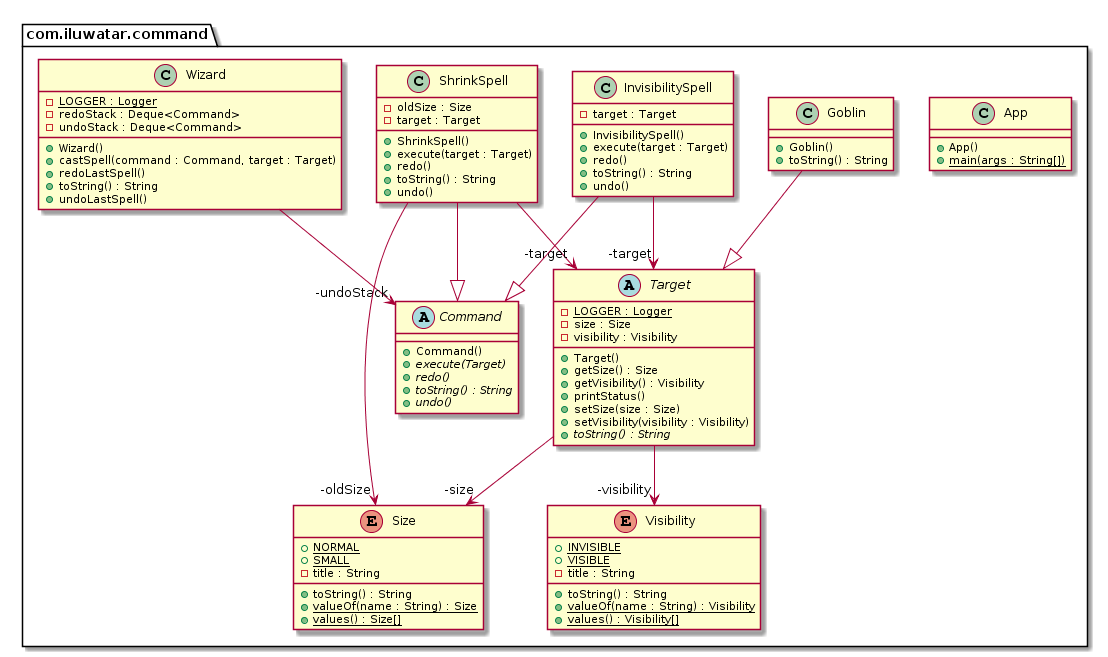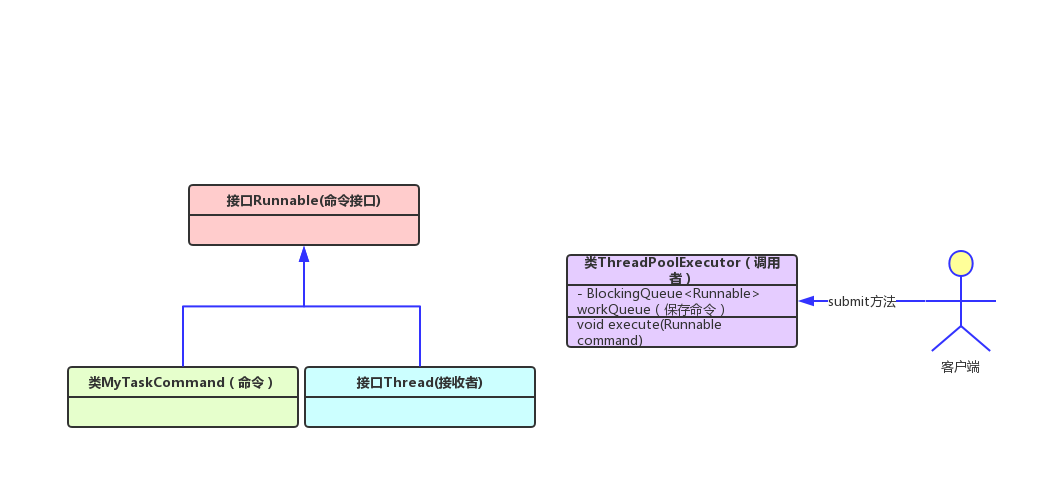public enum Size {
SMALL("small"), NORMAL("normal");
private String title;
Size(String title) {
this.title = title;
}
@Override
public String toString() {
return title;
}
}
public enum Visibility {
VISIBLE("visible"), INVISIBLE("invisible");
private String title;
Visibility(String title) {
this.title = title;
}
@Override
public String toString() {
return title;
}
}
public abstract class Command {
public abstract void execute(Target target);
public abstract void undo();
public abstract void redo();
@Override
public abstract String toString();
}
public class ShrinkSpell extends Command {
private Size oldSize;
private Target target;
@Override
public void execute(Target target) {
oldSize = target.getSize();
target.setSize(Size.SMALL);
this.target = target;
}
@Override
public void undo() {
if (oldSize != null && target != null) {
var temp = target.getSize();
target.setSize(oldSize);
oldSize = temp;
}
}
@Override
public void redo() {
undo();
}
@Override
public String toString() {
return "Shrink spell";
}
}
public class InvisibilitySpell extends Command {
private Target target;
@Override
public void execute(Target target) {
target.setVisibility(Visibility.INVISIBLE);
this.target = target;
}
@Override
public void undo() {
if (target != null) {
target.setVisibility(Visibility.VISIBLE);
}
}
@Override
public void redo() {
if (target != null) {
target.setVisibility(Visibility.INVISIBLE);
}
}
@Override
public String toString() {
return "Invisibility spell";
}
}
public abstract class Target {
private static final Logger LOGGER = LoggerFactory.getLogger(Target.class);
private Size size;
private Visibility visibility;
public Size getSize() {
return size;
}
public void setSize(Size size) {
this.size = size;
}
public Visibility getVisibility() {
return visibility;
}
public void setVisibility(Visibility visibility) {
this.visibility = visibility;
}
@Override
public abstract String toString();
public void printStatus() {
LOGGER.info("{}, [size={}] [visibility={}]", this, getSize(), getVisibility());
}
}
public class Goblin extends Target {
public Goblin() {
setSize(Size.NORMAL);
setVisibility(Visibility.VISIBLE);
}
@Override
public String toString() {
return "Goblin";
}
}
public class Wizard {
private static final Logger LOGGER = LoggerFactory.getLogger(Wizard.class);
private Deque<Command> undoStack = new LinkedList<>();
private Deque<Command> redoStack = new LinkedList<>();
public Wizard() {
}
public void castSpell(Command command, Target target) {
LOGGER.info("{} casts {} at {}", this, command, target);
command.execute(target);
undoStack.offerLast(command);
}
public void undoLastSpell() {
if (!undoStack.isEmpty()) {
var previousSpell = undoStack.pollLast();
redoStack.offerLast(previousSpell);
LOGGER.info("{} undoes {}", this, previousSpell);
previousSpell.undo();
}
}
public void redoLastSpell() {
if (!redoStack.isEmpty()) {
var previousSpell = redoStack.pollLast();
undoStack.offerLast(previousSpell);
LOGGER.info("{} redoes {}", this, previousSpell);
previousSpell.redo();
}
}
@Override
public String toString() {
return "Wizard";
}
}
public class App {
public static void main(String[] args) {
var wizard = new Wizard();
var goblin = new Goblin();
goblin.printStatus();
wizard.castSpell(new ShrinkSpell(), goblin);
goblin.printStatus();
wizard.castSpell(new InvisibilitySpell(), goblin);
goblin.printStatus();
wizard.undoLastSpell();
goblin.printStatus();
wizard.undoLastSpell();
goblin.printStatus();
wizard.redoLastSpell();
goblin.printStatus();
wizard.redoLastSpell();
goblin.printStatus();
}
}
|



